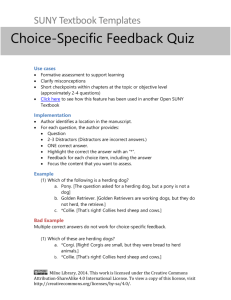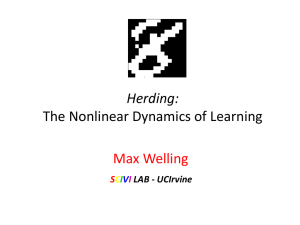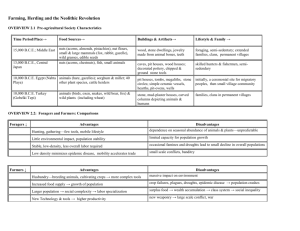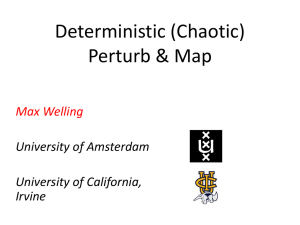Herd Behaviour - School of Computer Science and Statistics (SCSS)
advertisement
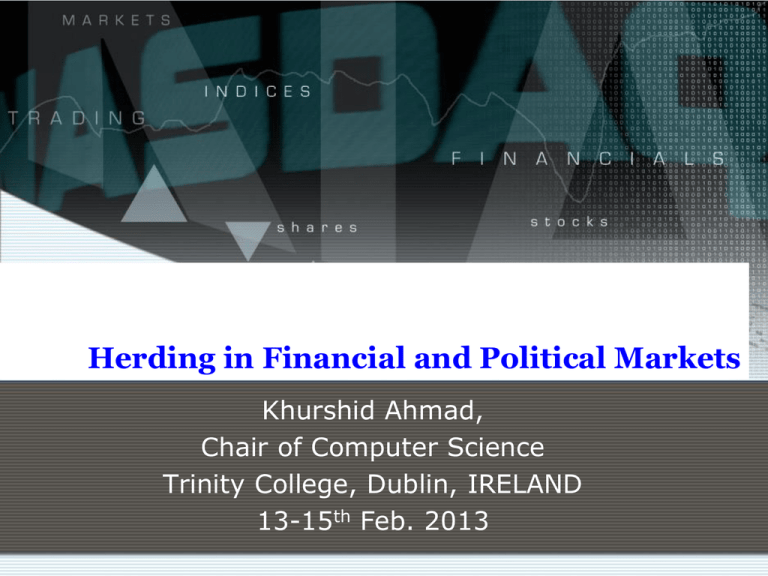
Herding in Financial and Political Markets Khurshid Ahmad, Chair of Computer Science Trinity College, Dublin, IRELAND 13-15th Feb. 2013 I flock, you flock, we flock Herd behaviour is in part inherited, safety in numbers, reliable peers, and in part learnt possibly by imitation). Herd behaviour is good and herd behaviour is bad. Herding Basics and Migrating Flocks Herd behavior describes how individuals in a group can act together without planned direction. The term pertains to the behavior of animals in herds, flocks and schools, and to human conduct during activities such as stock market bubbles and crashes, street demonstrations, sporting events, religious gatherings, episodes of mob violence and even everyday decision making, judgment and opinion forming. http://en.wikipedia.org/wiki/Herd_behavio Herding Basics and Migrating Flocks Collective aggregation behaviour is a ubiquitous biological phenomenon [….]The most established candidates for stimuli driving its evolution are foraging efficiency [….] and reducing predation risk. Andrew J. Wood and Graeme J. Ackland. (2007 ). Evolving the selfish herd: emergence of distinct aggregating strategies in an individual-based model. Proc. R. Soc. B , Vol. 274, pp 1637–1642 Herding Basics Herd behaviour causes individuals to over value public information and undervalue private information. Herding Basics: Bubbles The Dotcom Herd Herd behavior was exhibited in the late 1990s as venture capitalists and private investors were frantically investing huge amounts of money into internet-related companies, even though most of these dotcoms did not (at the time) have financially sound business models. The driving force that seemed to compel these investors to sink their money into such an uncertain venture was the reassurance they got from seeing so many others do the same thing. http://www.investopedia.com/university/behavioral_finance/behavioral8.asp Herding Basics: Public & Private Information In an experiment with 7 traders, Cipriani and Guarino conducted a trading experiment where the participants actually traded with ‘real’ money. There was evidence of herd behaviour in their experiment: Decision Percentage Following Private Information 45.7% Partially Following Private information 19.6% Cascade Trading 19.0% Cascade No-Trading 12.3% Errors 3.4% Total 100% Marco Cipriani and Antonio Guarino (2008). Herd Behavior in Financial Markets: An Experiment with Financial Market Professionals. IMF Working Paper WP/08/141. (http://www.imf.org/external/pubs/ft/wp/2008/wp08141.pdf) Herding Basics: Incentives and Reputational Herding In a study of the performance of 2345 hedge funds, and their managers, between 1994-2004, Nicole Boyson found: Fund Type Tendency to herd in Managers More Experienced Less Experienced Hedge Funds Yes No Mutual Funds No Yes Boyson, Nicole. M (2010). Implicit incentives and reputational herding by hedge fund managers. Journal of Empirical Finance. Vol. 17, pp 283-299 Herding Basics: Crossing continents “Foreign investors” bring investment as well as volatility • international investors' tend to mimic each other's behavior, sometimes ignoring useful information—as one contributor to market volatility in developing countries. •a positive association between a country's lack of transparency and international investors' tendency to herd when investing in its assets. •if herding by international investors raises volatility or causes more frequent financial crises in emerging markets, it is related to these countries' transparency features. Shang-Jin Wei and Heather Milkiewicz (2003). A Global Crossing for Enronitis?: How Opaque Self-Dealing Damages Financial Markets around the World. Brookings Papers on Economic Activity. 2003. Herding Basics “the herding effect is more prominent during periods of market losses”: During the loss making period there are “limited diversification opportunities for investors in this market, especially during periods of market losses when diversification is most needed” Is this happening in emerging markets as well? Riza Demirer, Ali M. Kutan, Chun-Da Chen (2010) Do investors herd in emerging stock markets?: Evidence from the Taiwanese market. Journal of Economic Behavior & Organization 76 (2010) 283–295 Herding Basics Herd behaviour is said to be one of the reasons behind stock price bubbles, and the probability of herd behaviour is positively correlated with the ambiguity of the distribution of stock returns as well as the disparity between traders and market makers’ attitudes towards this ambiguity. Zhiyong Dong, Qingyang Gu, and Xu Han (2010). Ambiguity aversion and rational herd behaviour. Applied Financial Economics, Vol. 20,pp 331–343 Herding Basics: A model The simplest model of herding is probably the following. There are two possible states and the agents’ decision consists of either investing or refraining from investing. In the good state the investment yields a positive return and in the bad state it yields zero. Each agent gets an informative signal about the true state, and the signals are i.i.d. The cost of investment is one half of the return in the good state, and the prior probability of the good state is one half. This means that the agents are indifferent between investing and refraining when they have but the prior information. If they get a good signal they strictly prefer to invest and if they get a bad signal they strictly prefer to refrain. More generally, if an agent, by observing the actions of his predecessors, can infer that the number of good signals is greater than the number of bad signals he prefers to invest. In the opposite case he prefers to refrain. Klaus K. Kultti and Paavo A. Miettinen(2010). Herding with Costly Observation. The B.E. Journal of Theoretical Economics, Vol. 7 [2007], Iss. 1 (Topics), Art. 28 Herding Basics: Out of one market frying pan into another’s fire: Gold Herding: A Causality Haiss, Peter. (2010). Bank Herding and Incentive Systems as Catalysts for the Financial Crisis. The IUP Journal of Behavioral Finance, Vol. 7 (Nos.1&2) pp31-58. Herding Basics Herd behaviour is a classic case of multi-sensory fusion and shows how Herbert Simon and Daniel Kahneman and company’s fast and slow mode of thinking and reacting are in operation. Herding Basics Herd behaviour is one of the reasons behind stock price bubbles, and the probability of herd behaviour is positively correlated with the ambiguity of the distribution of stock returns as well as the disparity between traders and market makers’ attitudes towards this ambiguity. Zhiyong Dong, Qingyang Gu, and Xu Han (2010). Ambiguity aversion and rational herd behaviour. Applied Financial Economics, Vol. 20,pp 331–343 Behaviour and Financial Markets – The Euphoria The volume of trading in financial and commodity markets, and the sometimes the less than transparent relationship between investors’ demands and traditional metric of asset prices, is perhaps is related to those ‘who trade despite having no new information to impound on stock prices’ (Forbes 2009:119). ‘Noise’ traders invariably misprice assets through a series of small trades and to volume of trading and volatility in the prices. Forbes, William. (2009). Behavioural Finance. Chichester: John Wiley & Sons. Herding Basics: Evergrowing Equity Markets The New York Stock Exchange (NYSE) is a stock exchange located at 11 Wall Street in Lower Manhattan, New York City, USA. It is by far the world's largest stock exchange by market capitalization of its listed companies at US$13.39 trillion as of Dec 2010. The US GDP in 2009 was 14.39 trillion; the stocks traded on NYSE were 11.76 trillion Herding Basics: Evergrowing Equity Markets Annual Stock Mean & Volatility Stock Trading on the NYSE 1990-2009; 10000000000 1000000000 Volume Volume Variance 100000000 10000000 1990 1995 2000 2005 2010 Herding Basics: Evergrowing Equity Markets Herding Basics: Evergrowing Equity Markets Distribution of NYSE Traded Volume around annual mean (1999-2009); 5043 data points 30% 25% 20% 15% 10% 5% 0% -6 -5 -4 -3 -2 -1 0 1 2 Deviation from mean 3 4 5 6 7 8 Herding Basics: Evergrowing Equity Markets Total Occurrences in Traded Volume at NYSE Prediction by Random Walk Deviation from Mean within Every X days Every X days 1 Std. Dev. 2 1.5 2 Std. Dev. 3 4 3 Std. Dev. 18 23 4 Std. Dev. 68 379 5 Std. Dev. 174 15931 6 Std. Dev. 630 1750302 Mean Volume traded= 1 Billion stocks/ per day Volatility in Trading= 250-800 million stocks/per day Herding Herds Shreds Commodity Markets http://www.thebureauinvestigates.com/2011/06/28/banks-trade-food-as-world-goes-hungry/ Herding Herds Shreds Commodity Markets Contagion effect and the integration of commodity markets • commodity markets [...] are more and more integrated, raising the fear of systemic risk. •The tightening of cross market linkages, means that a shock induced by traders or speculators may spread, not only to the physical market, but also to other derivative markets. •This question has been investigated through different ways. The first is the study of the impact of traders on derivative markets through the such-called “herding phenomenon”. The second is the study of spatial and temporal integration http://basepub.dauphine.fr/bitstream/handle/123456789/1227/Energy%20finance.pdf?sequence=1 Herding Herds Shred Commodity Markets http://finance.fortune.cnn.com/2011/02/02/why-cattle-markets-are-having-a-cow/ Herding Herds Shred Commodity Markets Financial Investment in Commodity Markets: Potential Impact on Commodity Prices & Volatility:I IF Commodities Task Force Submission to the G20. Institute of International Finance., 2011 Noise, noisy traders and herding? The effects of noise on the world, and on our views of the world, are profound. Noise [is rooted in][...] a small number of small events [and] is often a causal factor much more powerful than a small number of large events can be’. Noise causes to be somewhat inefficient, but often prevents us from taking advantages of the inefficiencies. Black, Fischer. (1986). Noise. Journal of Finance. Vol 41 (No.3). 529-541 Noise, noisy traders and herding? •Financial markets and media streams are expected to aggregate about investment of money and votes respectively. •However, in many instances, markets and media tend to stifle information related to endogenous and exogenous variables in ‘an echo chamber of platitudes’ (Forbes 2009:221). •These platitudes coupled with human tendency of risk seeking leads to evolution of noise and noise traders. Black, Fischer. (1986). Noise. Journal of Finance. Vol 41 (No.3). 529-541 Noise, noisy traders and herding? Noise, noisy traders and herding? • Is caused by a projection of future tastes and technology by sector causes business cycles; these cycles cannot be controlled by interventions (statal or corporate); • Is about irrational expectations about fiscal and monetary systems and are largely immune to remedies (statal or corporate); Black, Fischer. (1986). Noise. Journal of Finance. Vol 41 (No.3). 529-541 Noise has many forms: Noise, noisy traders and herding? But the memory and the impact of noise is not long lasting . The presence of noise is not easily incorporated in theoretical systems, that by virtue of academic tradition of clarity and pedagogic import, discount noise in the formulation of economic and finance theories. Noise, noisy traders and herding? •The noise can be introduced by •Experts commenting on the state of the market and projecting on the future with theories that deal mainly with some critical aspects of the market technical analysis for looking only at trends; relying on simplifying assumptions about the behaviour of prices and volumes traded assumption of normality. •The dependence of the experts on one or more stakeholders; • Technology that provides ways and means of accessing markets that were hitherto unavailable only a few years ago electronic trading, algo-sniffing; agencement – an endless network of traders, machines, investors leading to opaque markets •Discounting affect altogether efficient market hypothesis; ignoring the difference in wealth accrual and the utility of the wealth to those who acquire it. Herding as a contingency Assume that there are two kinds of traders only in a market: informed traders and noise traders. The noise trader fails to ascertain the true value of an asset and relies on guesswork, heuristics, imitation of the informed trader, or prayer. The noise trader misprices and the informed trader should see this as an opportunity to create a margin through arbitrage. This arbitrage is not always possible and worse still the informed tries to follow the noise trader. Herding as a contingency Assume that there are two kinds of traders only in a market: informed traders and noise traders. The noise trader fails to ascertain the true value of an asset and relies on guesswork, heuristics, imitation of the informed trader, or prayer. The noise trader misprices and the informed trader should see this as an opportunity to create a margin through arbitrage. This arbitrage is not always possible and worse still the informed tries to follow the noise trader. Noise Traders Informed Pessimistic Optimistic Pessimistic Herding Short-sell Optimistic Buy Herding Herding as contingency: DSSW Model DeLong, Shleifer, Summers and Waldman have presented ‘a simple overlapping generations model of an asset market in which irrational noise traders with erroneous stochastic beliefs both affect prices and earn higher expected returns.’ According to the authors, ‘the unpredictability of noise traders’ beliefs creates a risk in the price of the asset that deters rational arbitrageurs from aggressively betting against them.’ This misperception of correct price of the asset can lead to situations where the prices ‘can diverge significantly from fundamental values even in the absence of fundamental risk’. DeLong, B., A. Shleifer, L. Summers and R.Waldman (1990). Noise trader risk in financial markets. Journal of Political Economy. Vol 98, pp 703-38. Forbes, William. (2009). Behavioural Finance. Chichester: John Wiley & Sons. Herding as a contingency Forbes, William. (2009). Behavioural Finance. Chichester: John Wiley & Sons. Herding as a contingency Forbes, William. (2009). Behavioural Finance. Chichester: John Wiley & Sons. Herding as a contingency Forbes, William. (2009). Behavioural Finance. Chichester: John Wiley & Sons. Herding as a contingency Forbes, William. (2009). Behavioural Finance. Chichester: John Wiley & Sons. Herding as a contingency Forbes, William. (2009). Behavioural Finance. Chichester: John Wiley & Sons. Herding as a contingency Forbes, William. (2009). Behavioural Finance. Chichester: John Wiley & Sons. Herding as a contingency Forbes, William. (2009). Behavioural Finance. Chichester: John Wiley & Sons. Herding as a contingency Constant λ is the informed trader’s risk aversion factor; ρ changing value of noise trader’s mispricing of an asset Forbes, William. (2009). Behavioural Finance. Chichester: John Wiley & Sons. Herding in Financial Markets ‘LTCM’s basic strategy was ‘convergence’ and ‘relative-value’ arbitrage: the exploitation of price differences that either must be temporary or have a high probability of being temporary. Typical were its many trades involving ‘swaps’: by the time of LTCM’s crisis, its swap book consisted of some 10,000 swaps with a total notional value of $1.25 trillion.’ (MacKenzie 2003:354). Donald MacKenzie (2003). Long-Term Capital Management and the sociology of arbitrage. Economy and Society, Vol 32 (No. 3), pp 349-380 The value of $1,000 invested in LTCM, the Dow Jones Industrial Average and invested monthly in U.S. Treasuries at constant maturity. Economics, Finance and Behaviour So what herd behaviour has to do with sentiment clustering: if the sentiment in formal media follows sentiment in informal media Herding Finding Bull and Bear Herds in Financial Markets “ intentional herding is likely to be better revealed using intraday data, and that the use of a lower frequency data may obscure results revealing imitative behaviour in the market. ‘’ Blasco, N; Corredor,; Ferreruela, S. (2011). Detecting intentional herding: what lies beneath intraday data in the Spanish stock market. The Journal of the Operational Research Society Vol 62 (No.6) (Jun 2011), 1056-1066 Economics, Finance and Behaviour There are, it appears two polar views [bank] herding’: 1.Rational Herding; 2. Behavioral Herding Haiss, Peter (2010). ‘Bank Herding and Incentive Systems as Catalysts for the Financial Crisis’. The IUP Journal of Behavioral Finance. Vol 7 (Nos. 1 &2), pp 30-58 Economics, Finance and Behaviour 1. Rational Herding This includes information cascades: prior investment analyst choices influence post choices small bank operative follow large bank operative into sub-prime and risky loans Information asymmetries cause cascading. Reputation-based herding relates to riskseeking/risk averse behaviour precipitated by investment managers/gurus who are famous/notorious for their choice of assets; Haiss, Peter (2010). ‘Bank Herding and Incentive Systems as Catalysts for the Financial Crisis’. The IUP Journal of Behavioral Finance. Vol 7 (Nos. 1 &2), pp 30-58 Economics, Finance and Behaviour 1. Rational Herding Compensation: Investment managers are remunerated on the return performance of other managers […] rather than on absolute performance. This may lead to herd behaviour as investment managers merely follow other investment managers. Payoff Externalities: Refusal to re-negotiate outstanding loans of a distressed firm by one bank may lead to others to follow (similar to depositors running on distressed banks) in a herd. ‘The observation of payoffs from the repeated actions of other firms may similarly lead to boom and bust patterns in the adoption of financial innovations [like securitization]’ (Haiss 2010:37) Haiss, Peter (2010). ‘Bank Herding and Incentive Systems as Catalysts for the Financial Crisis’. The IUP Journal of Behavioral Finance. Vol 7 (Nos. 1 &2), pp 30-58 Economics, Finance and Behaviour Behavioral herding Dependence of behaviour upon the observed behaviour of others, or the results of behaviour; Procrastination in taking a decision and then rushing to implement it; Imitation Responding to affect Haiss, Peter (2010). ‘Bank Herding and Incentive Systems as Catalysts for the Financial Crisis’. The IUP Journal of Behavioral Finance. Vol 7 (Nos. 1 &2), pp 30-58 Herding in Markets We know of traders in financial and commodity markets mimicking each other and not being cognisant of their private information which contradicts what is happening in the markets; we know about long queues of depositors acting on rumour and literally follow their codepositors; but do institutions act like herds? Banks for example????????? Herding: Ambiguity and Crowds An important issue in modern financial theories is to study how agents make decisions on investments under risk, which is quite different from the concept of ambiguity. If the value functions of market makers and traders are homogeneous, herd behaviour will never happen even if ambiguity exists; if some types of traders have different attitudes towards ambiguity from market makers, then herd behaviour will happen with a positive probability. Zhiyong Dong, Qingyang Gu, and Xu Han (2010). Ambiguity aversion and rational herd behaviour. Applied Financial Economics, Vol. 20,pp 331–343 A Typology of Herding? There are, it appears two polar views [bank] herding’: 1.Rational Herding; 2. Behavioral Herding Haiss, Peter (2010). ‘Bank Herding and Incentive Systems as Catalysts for the Financial Crisis’. The IUP Journal of Behavioral Finance. Vol 7 (Nos. 1 &2), pp 30-58 Economics, Finance and Behaviour Incentive structures faced by bank managers appear ‘central’ in mitigating ‘herding, as myopic and asymetric reward structures in many banks were among the key drivers of the excess of the most recent financial boom [..]’ (Haiss 2010:50) Haiss, Peter. (2010). Bank Herding and Incentive Systems as Catalysts for the Financial Crisis. The IUP Journal of Behavioral Finance, Vol. 7 (Nos.1&2) pp31-58. Herding in Markets In a study of the performance of 2345 hedge funds, and their managers, between 1994-2004, Nicole Boyson found Fund Type Tendency to herd in Managers More Experienced Less Experienced Hedge Funds Yes No Mutual Funds No Yes Boyson, Nicole. M (2010). Implicit incentives and reputational herding by hedge fund managers. Journal of Empirical Finance. Vol. 17, pp 283-299 Herding in Audit Committees It has been shown that “herding equilibrium exists in which the audit committee ‘‘herds’’ and follows the auditor’s judgement no matter what its own insights suggest.” Barbara Schöndube-Pirchegger, Jens Robert Schöndube. (2011). Reputation concerns and herd behavior of audit committees - A corporate governance problem Journal Of Accounting And Public Policy Volume: 30 (4), p. 327-347. Analyst-led Herding Do ‘sell-side analysts herd around the consensus when they make stock recommendations? “empirical results support the herding hypothesis. Stock price reactions following recommendation revisions are stronger when the new recommendation is away from the consensus than when it is closer to it, indicating that the market recognizes analysts’ tendency to herd. Analysts from larger brokerages, analysts following stocks with smaller dispersion across recommendations, and analysts who make less frequent revisions are more likely to herd. Narasimhan Jegadeesh and Woojin Kim (2010). Do Analysts Herd? An Analysis of Recommendations and Market Reactions The Review of Financial Studies. v 23 (No. 2) pp 902:934 Analyst-led herding The key distinction between forecasts and recommendations is that when analysts make forecast revisions, they rationally incorporate information in the consensus forecasts even if that information is stale to the market. However, analysts do not revise their recommendations based on information already reflected in market prices because their recommendations are based on prevailing market prices[...]. Moreover, analysts revise recommendations in discrete levels. Most commonly, analyst recommendations rate stocks as “strong buy,” “buy,” “hold,” “sell,” and “strong sell.” Analysts also use other labels such as “market underperform” and “market outperform,” or “underweight” and “overweight,” to convey their opinions Narasimhan Jegadeesh and Woojin Kim (2010) Do Analysts Herd? An Analysis of Recommendations and Market Reactions. The Review of Financial Studies Vol. 23 (No.2). pp 902-937. Analyst-led Herding: Forecasts and Recommendations Period 1983-2005 Firms followed 5714 Analysts followed 6588 Brokerages Mean analysts/brokerage Mean analysts following each firm 444 19.27 7.45 Narasimhan Jegadeesh and Woojin Kim (2010) Do Analysts Herd? An Analysis of Recommendations and Market Reactions. The Review of Financial Studies Vol. 23 (No.2). pp 902-937. Analyst-led Herding: Forecasts and Recommendations Recommendation revision Obs. Returns since a number of trading days since revision 0 1 2 21 42 126 Upgrades 34,385 2.0 2.3 2.4 3.3 3.6 4.8 Downgrades 37,170 −3.2 −3.4 −3.5 −3.8 −3.8 −3.6 Reiterations 11,690 −0.11 −0.12 −0.05 −0.16 0.3 2.0 Narasimhan Jegadeesh and Woojin Kim (2010) Do Analysts Herd? An Analysis of Recommendations and Market Reactions. The Review of Financial Studies Vol. 23 (No.2). pp 902-937. Analyst-led Herding: Forecasts and Recommendations Recommendation revision Obs. Upgrades Toward—away consensus Downgrades Toward—away consensus Reiterations Number of trading days since revision 0 1 2 21 42 126 34,385 2.0 2.3 2.4 3.3 3.6 4.8 1583517391 −0.4 −0.4 -0.5 -0.3 -0.2 −0.5 37,170 −3.2 −3.4 −3.5 −3.8 −3.8 −3.6 1717718682 1.6 1.6 1.5 1.8 1.8 2.1 11,690 −0.11 −0.12 −0.05 −0.16 0.3 2.0 Narasimhan Jegadeesh and Woojin Kim (2010) Do Analysts Herd? An Analysis of Recommendations and Market Reactions. The Review of Financial Studies Vol. 23 (No.2). pp 902-937. Herding amongst Central Bankers There is some evidence of herding from the deliberations of the various committees, and indeed the Council of the revered Budensbank, comprising of some individuals that are open about their econo-political orientation (left/right, conservative/social democrat). Berger and Woitek (2005) have noted that, for example, in setting the key discount rate ‘political background of [the Council] member matters’. More importantly for us: ‘there is some herd behaviour: the dissenting vote was highly correlated among groups. [...] all groups were more inclined to vote no if members of other groups did so as well.’( ibid:752) Helge Berger and Ulrich Woitek (2005). DOES CONSERVATISM MATTER? A TIME-SERIES APPROACH TO CENTRAL BANK BEHAVIOUR. The Economic Journal, Vol 115 (July), 745–766. Instances of Rational Herding Haiss, Peter (2010). ‘Bank Herding and Incentive Systems as Catalysts for the Financial Crisis’. The IUP Journal of Behavioral Finance. Vol 7 (Nos. 1 &2), pp 30-58 Instances of Rational Herding Haiss, Peter (2010). ‘Bank Herding and Incentive Systems as Catalysts for the Financial Crisis’. The IUP Journal of Behavioral Finance. Vol 7 (Nos. 1 &2), pp 30-58 Instances of Rational Herding Haiss, Peter (2010). ‘Bank Herding and Incentive Systems as Catalysts for the Financial Crisis’. The IUP Journal of Behavioral Finance. Vol 7 (Nos. 1 &2), pp 30-58 Instances of Behavioral Herding Haiss, Peter (2010). ‘Bank Herding and Incentive Systems as Catalysts for the Financial Crisis’. The IUP Journal of Behavioral Finance. Vol 7 (Nos. 1 &2), pp 30-58 Instances of Rational/Behavioral Herding Haiss, Peter (2010). ‘Bank Herding and Incentive Systems as Catalysts for the Financial Crisis’. The IUP Journal of Behavioral Finance. Vol 7 (Nos. 1 &2), pp 30-58 Herding and Incentive Structures Incentive structures faced by bank managers appear ‘central’ in mitigating ‘herding, as myopic and asymetric reward structures in many banks were among the key drivers of the excess of the most recent financial boom [..]’ (Haiss 2010:50) Haiss, Peter. (2010). Bank Herding and Incentive Systems as Catalysts for the Financial Crisis. The IUP Journal of Behavioral Finance, Vol. 7 (Nos.1&2) pp31-58. Herding Herds Shreds Commodity Markets http://nobelprize.org/nobel_prizes/economics/laureates/2002/smith-lecture.pdf Herding Herds Shreds Commodity Markets Oil Future (CL1): Price http://wikiposit.org/05/futget?ticker=CL&month=1 Herding Herds Shreds Commodity Markets Oil Future (CL1): Volume http://www.wikiposit.com/plot?Y2h0P Anti-herding and herding in commodity markets CL1 Price CL1 Volume Pierdzich et al (2010) have looked at the oilprice forecasts of the Survey of Professional Forecasters published by the European Central Bank to analyze whether oil-price forecasters herd or anti-herd. They conclude that ‘Oil-price forecasts are consistent with herding (anti-herding) of forecasters if forecasts are biased towards (away from) the consensus forecast’. Christian Pierdzioch , Jan Christoph Rülke , and Georg Stadtmann (2010). New evidence of anti-herding of oil-price forecasters. Energy Economics . Vol. 32, pp 1456-1459 Herding Herds Shreds Commodity Markets There is little convincing evidence linking financial investment with trends in commodity prices and volatility. While there have been periods of correlation (sometimes attributed to "herding" behavior) in recent years, including among previously uncorrelated markets, researchers have not documented a clear causal link between financial investment and commodity prices. In theory the price effect of commodity financial investment is ambiguous. On the one hand, well-informed, rational investors should add liquidity to commodity derivatives market, facilitating price discovery and keeping prices more aligned with fundamentals. As commodity investors buy when prices are low and sell when prices are high, this should help clear the market. However, some argue that “ill informed” investors exhibiting herding behavior could add to price volatility [...] Financial Investment in Commodity Markets: Potential Impact on Commodity Prices & Volatility:I IF Commodities Task Force Submission to the G20. Institute of International Finance., 2011, pp 5-6 Herding Across Financial Markets Herding in Financial Markets Long-Term Capital Management L.P. (LTCM) was a hedge fund management firm that utilized absolute-return trading strategies, including fixed-income arbitrage, statistical arbitrage, and pairs trading, combined with high leverage. Founded in 1994 and had annualised returns of over 40% until 1997. The firm, got entangled in the transformation of Russia from a controlled economy to a market-based economy, and was bailed-out after making losses of $4.6Billion in 1998 by other institutions under the guidance of the US Federal Reserve John Meriwether, formerly of Salomon Brothers, founded LCTM in 1994 and had the Economic Science Nobel Lauerates (1997) Myron Scholes and Robert C. Merton on its Board of Directors. http://en.wikipedia.org/wiki/Long-Term_Capital_Management Herding Basics: Lock-stepping Stocks Floyd Norris writes a ‘must-read’ financial blog in the New York Times. This is what he had to say on August 16, 2010. Herding Basics: Lock-stepping Stocks August 2011 Herd mentality has descended upon Wall Street, as S&P 500 stock correlation reaches its highest levels ever. This unseats former records set in 1987, when portfolio insurance strategies caused stocks to tumble in tandem. Analysts have learned to expect high correlation in bear markets, when investors rush to sell off equities. But Felix Salmon has noted that the rise of highfrequency trading and ETFs could mean that high correlation is just part of a larger trend. Either way, this spike in correlation is far from reassuring for markets. http://articles.businessinsider.com/2011-08-24/markets/30076940_1_herd-mentality-correlation-investors-rush August 2011 Herding Basics: Lock-stepping Stocks The correlation of moves in individual stocks and the S&P 500 index is at a record, making the job of long-only mutual fund managers to differentiate from the benchmark virtually impossible, according to a report from Goldman Sachs. The correlation for the S&P 500 and its members is at 0.73, according to Goldman, meaning that the majority of stocks move in lockstep with the index on a daily basis. This is at least the highest in 20 years and therefore likely a record "Record high S&P 500 and sector correlation poses a challenge for fundamental investors," said David Kostin, chief U.S. investment strategist at Goldman Sachs, in the Friday note. Herding Basics: Lock-stepping Stocks Kostin and other traders believe this lemming behavior among individual stocks could be attributed to the popularity of exchangetraded funds, which allow investors to trade whole indexes and sectors as easily as individual stocks, and the surge in lighting fast highfrequency trading, the buying and selling of millions of stocks in milliseconds based on algorithmic models. Herding in Equity Markets Guo and Shih (2008) have examined the co-movement of stock prices and its association with herd behaviour during period of high-tech mania using the implications for return data and found 5 key points: 1. return dispersion and volatility dispersion are higher in high-tech industries. 2. directional co-movement of stock prices as a modified herding measure to investigate herd behaviour for hightech stocks. Wen-Chung Guo and Hsiu-Ting Shih (2008). The co-movement of stock prices, herd behaviour and high-tech mania. Applied Financial Economics, Vol 18, pp 1343–1350 Herding in Equity Markets Guo and Shih (2008) have examined the co-movement of stock prices and its association with herd behaviour during period of high-tech mania using the implications for return data and found 5 key points: 3. return and volatility dispersion were not found to exhibit a consistent relation with extreme market conditions in the Taiwan market. 4. herding, measured by directional co-movement, is more prevalent in hightech industries, as compared to traditional economic industries 5. an asymmetric result that herding has great significance during extreme up markets. Wen-Chung Guo and Hsiu-Ting Shih (2008). The co-movement of stock prices, herd behaviour and high-tech mania. Applied Financial Economics, Vol 18, pp 1343–1350 Herding Herds Shreds Commodity Markets Herding Herds Shreds Commodity Markets http://commodities.about.com/b/2010/02/08/live-cattle-herding-higher.htm Herding Herds Shreds Commodity Markets Financial Investment in Commodity Markets: Potential Impact on Commodity Prices & Volatility:I IF Commodities Task Force Submission to the G20. Institute of International Finance., 2011 Herding across the markets: Equities and Commodities Financialization of commodity markets has led to “herding” and more correlation among previously uncorrelated asset classes A related argument states that the rising weight of financial investment in commodity futures markets— particularly via such practices as algorithmic trading and the “herding effect,” has led to investors being broadly indiscriminate among different asset classes—using information collected in one market (e.g. equities) to form expectations about price movements in another (e.g. commodities), irrespective of fundamentals in the latter.[..] This would suggest that financial investment has led to increasing correlation between commodities and other markets Financial Investment in Commodity Markets: Potential Impact on Commodity Prices & Volatility:I IF Commodities Task Force Submission to the G20. Institute of International Finance., 2011, pp 5-6 I flock, you flock, we flock What interests me is the socalled herd behaviour that can be observed in the different segments of human society. Exuberant financial trading is one example. Exuberant labeling of groups of people is another. Exuberant scientists is yet another example I flock, you flock, we flock Exuberant behaviour: reckless risk taking; unwarranted self belief shared with an equally (mis)informed community; no rational basis for evaluation; always related to the 5-year boom-busts we have gotten used to (dot com, sub-prime)
